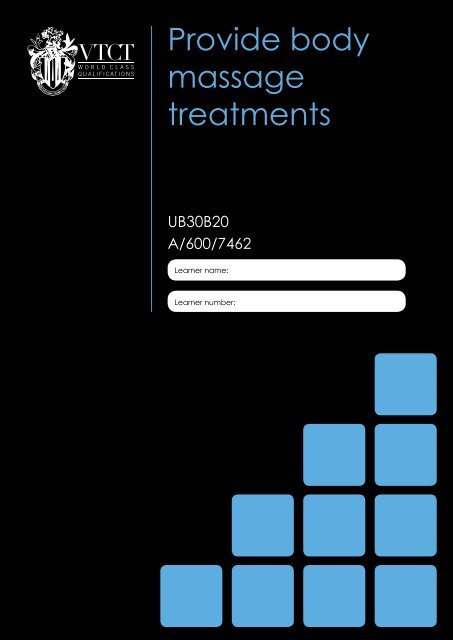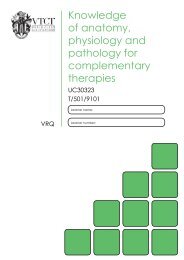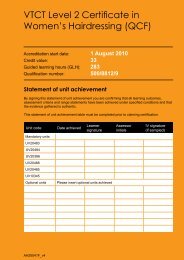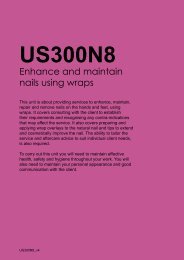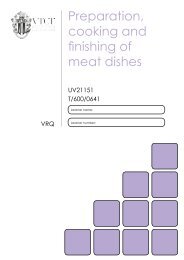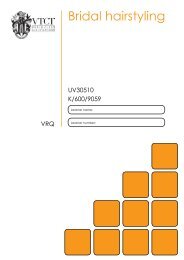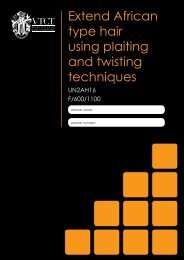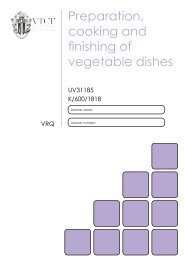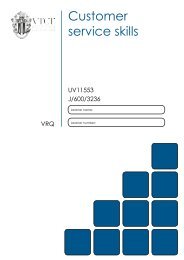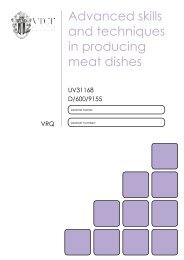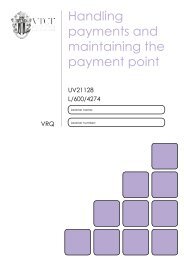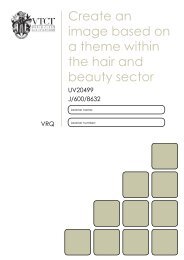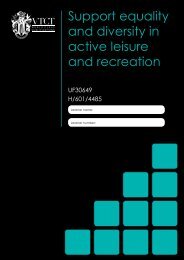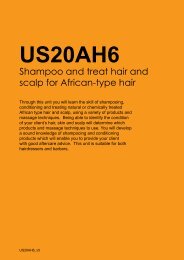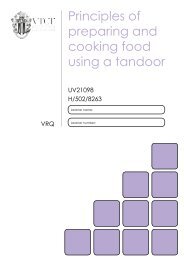Provide body massage treatments - VTCT
Provide body massage treatments - VTCT
Provide body massage treatments - VTCT
Create successful ePaper yourself
Turn your PDF publications into a flip-book with our unique Google optimized e-Paper software.
<strong>Provide</strong> <strong>body</strong><br />
<strong>massage</strong><br />
<strong>treatments</strong><br />
UB30B20<br />
A/600/7462<br />
Learner name:<br />
Learner number:
Statement of unit achievement<br />
<strong>VTCT</strong> is the specialist awarding <strong>body</strong> for the Hairdressing, Beauty Therapy,<br />
Complementary Therapy and Sport and Active Leisure sectors, with over 45<br />
years of experience.<br />
<strong>VTCT</strong> is an awarding <strong>body</strong> regulated by national organisations including<br />
Ofqual, SQA, DCELLS and CCEA.<br />
<strong>VTCT</strong> is a registered charity investing in education and skills but also giving to<br />
good causes in the area of facial disfigurement.<br />
By signing this statement of unit achievement you are confirming that all learning outcomes, assessment<br />
criteria and range statements have been achieved under specified conditions and that the evidence<br />
gathered is authentic.<br />
This statement of unit achievement table must be completed prior to claiming certification.<br />
Unit code Date achieved Learner signature<br />
Assessor tracking table<br />
Assessor name Assessor signature<br />
Assessor<br />
initials<br />
Assessors<br />
initials<br />
IV signature<br />
(if sampled)<br />
All assessors using this Record of Assessment book must complete this table. This is required for<br />
verification purposes.<br />
Assessor number<br />
(optional)
UB30B20<br />
<strong>Provide</strong> <strong>body</strong> <strong>massage</strong><br />
<strong>treatments</strong><br />
This unit is about the skills involved in providing head and<br />
<strong>body</strong> <strong>massage</strong> <strong>treatments</strong>. It covers manual <strong>massage</strong> of<br />
the head and <strong>body</strong> as well as mechanical <strong>body</strong> <strong>massage</strong><br />
techniques. The ability to adapt <strong>massage</strong> techniques to suit<br />
individual client needs is a crucial requirement of this unit.<br />
To carry out this unit you will need to maintain effective<br />
health, safety and hygiene throughout your work. You will<br />
also need to maintain your personal appearance and good<br />
communication with the client.<br />
UB30B20_v7
NOS<br />
Level<br />
Credit value<br />
GLH<br />
B20<br />
3<br />
10<br />
79<br />
Observations<br />
4<br />
External paper(s)<br />
2
<strong>Provide</strong> <strong>body</strong> <strong>massage</strong><br />
<strong>treatments</strong><br />
Learning outcomes<br />
On completion of this unit you will:<br />
1. Be able to maintain safe and effective<br />
methods of working when providing <strong>body</strong><br />
<strong>massage</strong> <strong>treatments</strong><br />
2. Be able to consult, plan and prepare to<br />
provide <strong>body</strong> <strong>massage</strong> <strong>treatments</strong><br />
3. Be able to perform manual <strong>massage</strong><br />
<strong>treatments</strong><br />
4. Be able to perform mechanical <strong>massage</strong><br />
<strong>treatments</strong><br />
5. Understand organisational and legal<br />
requirements for protecting <strong>body</strong> <strong>massage</strong><br />
<strong>treatments</strong><br />
6. Understand how to work safely and<br />
effectively when providing <strong>body</strong> <strong>massage</strong><br />
<strong>treatments</strong><br />
7. Understand how to consult with clients<br />
8. Understand how to prepare to provide <strong>body</strong><br />
<strong>massage</strong> <strong>treatments</strong><br />
9. Understand anatomy and physiology related<br />
to <strong>body</strong> <strong>massage</strong> <strong>treatments</strong><br />
10. Understand contra-indications and<br />
contra-actions that affect or restrict <strong>body</strong><br />
<strong>massage</strong> <strong>treatments</strong><br />
11. Understand how to carry out <strong>body</strong> <strong>massage</strong><br />
<strong>treatments</strong><br />
12. Understand how to provide aftercare advice<br />
Evidence requirements<br />
1. Simulation is not allowed for any<br />
performance evidence within this unit.<br />
2. You must practically demonstrate in your<br />
everyday work that you have met the<br />
standard for providing <strong>body</strong> <strong>massage</strong><br />
<strong>treatments</strong>.<br />
3. Your assessor will observe your<br />
performance on at least 4 separate<br />
occasions, each on 4 different clients,<br />
which must include 2 full <strong>body</strong> <strong>massage</strong><br />
<strong>treatments</strong>, incorporating the face.<br />
One of the full <strong>body</strong> <strong>massage</strong>s must<br />
incorporate the use of mechanical<br />
<strong>massage</strong> and infra-red treatment.<br />
4. From the range, you must practically<br />
demonstrate that you have:<br />
• used all types of equipment on suitable<br />
treatment areas<br />
• used all of the <strong>massage</strong> mediums<br />
• used all consultation techniques<br />
• dealt with all the client’s physical<br />
characteristics<br />
• dealt with at least 1 of the necessary<br />
actions*<br />
• met all treatment objectives<br />
• used all <strong>massage</strong> techniques<br />
• covered all treatment areas<br />
• given all types of advice.<br />
* However, you must prove to your assessor<br />
that you have the necessary knowledge,<br />
understanding and skills to be able to<br />
perform competently in respect of all the<br />
items in these ranges.<br />
5. It is likely most evidence of your<br />
performance will be gathered from the<br />
observations made by your assessor, but<br />
you may be required to produce other<br />
evidence to support your performance if<br />
your assessor has not been present.<br />
6. Knowledge and understanding in this unit<br />
will be assessed by an external paper.<br />
The criteria that make up this paper are<br />
highlighted in white throughout this unit.<br />
There are two external papers that must<br />
be achieved.<br />
UB30B20<br />
3
4<br />
Achieving observations<br />
and range<br />
Achieving observation outcomes<br />
Your assessor will observe your performance<br />
of practical tasks. The minimum number<br />
of observations required is indicated in the<br />
evidence requirements section of this unit.<br />
Criteria may not always naturally occur during<br />
a practical observation. In such instances you<br />
will be asked questions to demonstrate your<br />
competence in this area. Your assessor will<br />
document the criteria that have been achieved<br />
through oral questioning.<br />
Your assessor will sign off an outcome when all<br />
criteria have been competently achieved in a<br />
single client service.<br />
Achieving range<br />
The range section indicates what must<br />
be covered. Ranges must be practically<br />
demonstrated as part of an observation. Your<br />
assessor will document the portfolio reference<br />
once a range has been competently achieved.<br />
UB30B20<br />
Maximum service times<br />
The following maximum service times apply to<br />
this unit:<br />
Back <strong>massage</strong> 30 minutes<br />
Full <strong>body</strong> <strong>massage</strong><br />
(excluding head and face) 60 minutes<br />
Full <strong>body</strong> <strong>massage</strong><br />
(including head and face) 75 minutes
Outcome 1<br />
You can:<br />
a. Set up and maintain the treatment area<br />
to meet legal, hygiene and service<br />
requirements<br />
b. Maintain personal hygiene, protection and<br />
appearance that meets accepted industry<br />
and organisational requirements<br />
c. Clean all tools and equipments using the<br />
correct methods<br />
d. Position equipment and <strong>massage</strong> mediums<br />
for safety and ease of use<br />
e. Position the client and yourself to minimise<br />
fatigue and risk of injury and for the<br />
treatment<br />
f. Use industry hygiene and safety practices<br />
throughout the treatment to minimise the<br />
risk of cross-infection<br />
g. Adopt a positive, polite and reasusuring<br />
manner towards the client throughout the<br />
treatment<br />
h. Maintain the client’s modesty, privacy and<br />
comfort throughout the treatment<br />
i. Complete the treatment within a<br />
commercially viable time<br />
*May be assessed through oral questioning.<br />
Observations<br />
Be able to maintain safe and effective methods of working<br />
when providing <strong>body</strong> <strong>massage</strong> <strong>treatments</strong><br />
Observation 1 2 3 4<br />
Criteria questioned orally<br />
Date achieved<br />
Portfolio reference<br />
Learner signature<br />
Assessor initials<br />
j. Keep the records up to date, accurate,<br />
easy to read and signed by the client and<br />
practitioner<br />
k. Leave the treatment area and equipment in<br />
a suitable condition for future <strong>treatments</strong><br />
UB30B20<br />
5
6<br />
Outcome 2<br />
Be able to consult, plan and prepare to provide <strong>body</strong> <strong>massage</strong><br />
<strong>treatments</strong><br />
You can:<br />
a. Use consultation techniques to determine<br />
the client’s treatment needs<br />
b. Obtain signed, written and informed consent<br />
prior to carrying out the treatment from the<br />
client or parent/guardian if the client is a<br />
minor*<br />
c. Question the client to identify the client’s<br />
medical history, physical characteristics and<br />
lifestyle pattern<br />
d. Consult with the client to identify any<br />
contra-indications to <strong>body</strong> <strong>massage</strong><br />
<strong>treatments</strong>, recording the client’s responses,<br />
taking any necessary action<br />
e. <strong>Provide</strong> client advice without referring to<br />
a specific medical condition and without<br />
causing undue alarm and concern*<br />
f. Explain and agree the projected cost, likely<br />
duration, frequency and types of treatment<br />
needed<br />
g. Agree in writing the client’s needs,<br />
expectations and treatment objectives,<br />
ensuring they are realistic and achievable<br />
*May be assessed through oral questioning.<br />
Observation 1 2 3 4<br />
Criteria questioned orally<br />
Date achieved<br />
Portfolio reference<br />
Learner signature<br />
Assessor initials<br />
UB30B20<br />
h. Clean and prepare the client’s skin to suit<br />
the type of <strong>massage</strong> to be given<br />
i. Protect the client’s clothing, hair and<br />
accessories prior to beginning <strong>massage</strong><br />
j. Select equipment and related products to<br />
suit the treatment objectives
Outcome 3<br />
Be able to perform manual <strong>massage</strong> <strong>treatments</strong><br />
You can:<br />
a. Check that the client’s <strong>body</strong> is suitably<br />
supported prior to and during the treatment<br />
b. Adapt <strong>massage</strong> techniques, sequence and<br />
<strong>massage</strong> mediums to meet the client’s<br />
physical characteristics and treatment<br />
area(s)<br />
c. Vary the depth, rhythm and pressure of<br />
<strong>massage</strong> movements to meet treatment<br />
objective, treatment area(s) and client’s<br />
physical characteristics and preferences<br />
d. Take prompt remedial action if<br />
contra-actions or discomfort occur during<br />
the course of treatment*<br />
e. Give the client sufficient post-treatment<br />
recovery time<br />
f. Apply and use <strong>massage</strong> oil medium to<br />
minimise waste<br />
g. Consult with the client to confirm the<br />
finished result is to the client’s satisfaction<br />
and meets the agreed treatment objectives<br />
h. <strong>Provide</strong> aftercare advice specific to the<br />
client’s individual needs<br />
*May be assessed through oral questioning.<br />
Observation 1 2 3 4<br />
Criteria questioned orally<br />
Date achieved<br />
Portfolio reference<br />
Learner signature<br />
Assessor initials<br />
UB30B20<br />
7
8<br />
Outcome 4<br />
Be able to perform mechanical <strong>massage</strong> <strong>treatments</strong><br />
You can:<br />
a. Explain to the client the sensation created<br />
by the equipment used<br />
b. Explain the treatment procedure to the client<br />
in a clear and simple way at each stage in<br />
the process<br />
c. Check the client’s <strong>body</strong> is suitably supported<br />
prior to and during the treatment<br />
d. Safely use the correct treatment settings,<br />
application and applicator heads on the<br />
<strong>body</strong> throughout the treatment to meet<br />
manufacturers’ instructions<br />
e. Adjust the intensity and duration of the<br />
treatment to suit the client’s physical<br />
characteristics and treatment area(s)<br />
f. Vary the sequence, depth and pressure of<br />
<strong>massage</strong> movements to meet treatment<br />
objectives and treatment area(s)<br />
g. Check the client’s wellbeing throughout the<br />
mechanical <strong>massage</strong> treatment<br />
h. Take prompt remedial action if<br />
contra-actions or discomfort occur during<br />
the course of treatment*<br />
*May be assessed through oral questioning.<br />
Observation 1 2 3 4<br />
Criteria questioned orally<br />
Date achieved<br />
Portfolio reference<br />
Learner signature<br />
Assessor initials<br />
UB30B20<br />
i. Give the client sufficient post-treatment<br />
recovery time<br />
j. Check the finished result is to the client’s<br />
satisfaction and meets the agreed treatment<br />
objectives<br />
k. <strong>Provide</strong> aftercare advice specific to the<br />
client’s individual needs
You must practically demonstrate you have:<br />
Range<br />
Used all types of equipment on suitable treatment areas Portfolio reference<br />
Gyratory <strong>massage</strong>r<br />
Audio sonic<br />
Infrared<br />
Used all of the <strong>massage</strong> mediums Portfolio reference<br />
Oil<br />
Cream<br />
Powder<br />
Used all consultation techniques Portfolio reference<br />
Questioning<br />
Visual<br />
Manual<br />
Reference to client records<br />
Dealt with all the client’s physical characteristics Portfolio reference<br />
Weight<br />
Height<br />
Posture<br />
Muscle tone<br />
Age<br />
Health<br />
Skin condition<br />
UB30B20 9
10<br />
You must practically demonstrate you have:<br />
Dealt with at least 1 of the necessary actions Portfolio reference<br />
Encouraging the client to seek medical advice<br />
Explaining why the treatment cannot be carried out<br />
Modification of treatment<br />
Met all treatment objectives Portfolio reference<br />
Relaxation<br />
Sense of wellbeing<br />
Uplifting<br />
Anti-cellulite<br />
Stimulating<br />
Used all <strong>massage</strong> techniques Portfolio reference<br />
Effleurage<br />
Petrissage<br />
Tapotement<br />
Vibration<br />
Friction<br />
UB30B20
You must practically demonstrate you have:<br />
Covered all treatment areas Portfolio reference<br />
Face<br />
Head<br />
Chest and shoulders<br />
Arms and hands<br />
Abdomen<br />
Back<br />
Gluteals<br />
Legs and feet<br />
Given all types of advice Portfolio reference<br />
Avoidance of activities which may cause contra-actions<br />
Future treatment needs<br />
Modifications to lifestyle patterns<br />
Healthy eating and exercise advice<br />
Suitable home care products and their use<br />
UB30B20 11
12<br />
Developing knowledge<br />
Achieving knowledge outcomes<br />
You will be guided by your tutor and assessor<br />
on the evidence that needs to be produced.<br />
Your knowledge and understanding will be<br />
assessed using the assessment methods listed<br />
below:<br />
• Observed work<br />
• Witness statements<br />
• Audio-visual media<br />
• Evidence of prior learning or attainment<br />
• Written questions<br />
• Oral questions<br />
• Assignments<br />
• Case studies<br />
Achieving the external paper<br />
UB30B20<br />
Where possible your assessor will integrate<br />
knowledge outcomes into practical observations<br />
through oral questioning.<br />
The external paper will test your knowledge of the criteria highlighted in white. A pass mark of<br />
70% must be achieved. Criteria not achieved will be identified to your tutor/assessor. You will then<br />
be orally questioned or asked to produce other forms of evidence as all unit criteria must<br />
be achieved.<br />
Your assessor will complete the table below when the 70% pass mark has been achieved.<br />
Paper Date achieved Assessor initials<br />
1 of 2<br />
2 of 2
Knowledge<br />
Outcome 5<br />
Understand organisational and legal requirements for<br />
protecting <strong>body</strong> <strong>massage</strong> <strong>treatments</strong><br />
You can: Portfolio reference<br />
a. Explain own responsibilities under relevant health and safety<br />
legislation, standards and guidance<br />
b. Explain own responsibilities under local authority licensing<br />
regulations for yourself and the premises<br />
c. Explain the importance of not discriminating against clients with<br />
illnesses and disabilities and why<br />
d. State the age at which an individual is classed as a minor and how<br />
this differs nationally<br />
e. Explain why it is important, when treating minors under 16 years of<br />
age, to have a parent or guardian present<br />
f. Explain why minors should not be given <strong>treatments</strong> without<br />
informed and signed parental or guardian present<br />
g. Explain the legal significance of gaining signed, informed consent<br />
to treatment<br />
h. Explain own responsibilities and reasons for maintaining personal<br />
hygiene, protection and appearance according to accepted<br />
industry and organisational requirements<br />
i. Explain the manufacturers’ and organisational requirements for<br />
waste disposal<br />
* Assessor initials to be inserted if orally questioned.<br />
Requirements highlighted in white are assessed in the external written paper.<br />
UB30B20 13
14<br />
Outcome 5 (continued)<br />
Understand organisational and legal requirements for<br />
protecting <strong>body</strong> <strong>massage</strong> <strong>treatments</strong><br />
You can: Portfolio reference<br />
j. Explain the importance of the correct storage of client records in<br />
relation to the Data Protection Act<br />
k. Explain how to complete the client records and the reasons for<br />
keeping records of <strong>treatments</strong> and gaining client signatures<br />
l. Explain the organisation’s requirements for client preparation<br />
m. Explain the organisation’s service times for <strong>body</strong> <strong>massage</strong><br />
<strong>treatments</strong> and the importance of completing the service in a<br />
commercially viable time<br />
n. Explain own responsibilities and reasons for keeping own nails<br />
short, clean, well-manicured and free of polish for <strong>massage</strong><br />
<strong>treatments</strong><br />
o. Explain the organisation’s and manufacturers’ requirements for<br />
treatment area, equipment maintenance and equipment cleaning<br />
regimes<br />
* Assessor initials to be inserted if orally questioned.<br />
Requirements highlighted in white are assessed in the external written paper.<br />
UB30B20
Outcome 6<br />
Understand how to work safely and effectively when providing<br />
<strong>body</strong> <strong>massage</strong> <strong>treatments</strong><br />
You can: Portfolio reference<br />
a. Explain how to set up the work area for <strong>body</strong> <strong>massage</strong> <strong>treatments</strong><br />
b. Explain the necessary environmental conditions for <strong>body</strong> <strong>massage</strong><br />
<strong>treatments</strong> (including lighting, heating, ventilation, sound and<br />
general comfort) and why these are important<br />
c. Explain the reasons for disinfecting hands and how to do this<br />
effectively<br />
d. Explain how to position yourself and the client for <strong>body</strong> <strong>massage</strong><br />
<strong>treatments</strong> taking into account individual physical characteristics<br />
e. Explain what repetitive strain injury (RSI) is, how it is caused and<br />
how to avoid developing it when delivering <strong>massage</strong> <strong>treatments</strong><br />
f. Explain the importance of adopting the correct posture throughout<br />
the treatment and the impact this may have on you and the<br />
outcome of the treatment<br />
g. Explain the reasons for maintaining client modesty, privacy and<br />
comfort during the treatment<br />
h. Explain why it is important to maintain standards of hygiene and<br />
the principles of avoiding cross-infection<br />
i. Explain how to minimise and dispose of waste <strong>treatments</strong><br />
j. Explain why it is important to check the client’s wellbeing at regular<br />
intervals during mechanical <strong>massage</strong><br />
* Assessor initials to be inserted if orally questioned.<br />
Requirements highlighted in white are assessed in the external written paper.<br />
UB30B20 15
16<br />
Outcome 7<br />
Understand how to consult with clients<br />
You can: Portfolio reference<br />
a. Explain how to use effective consultation techniques when<br />
communicating with clients from different cultural and religious<br />
backgrounds, ages, disabilities and genders for this treatment<br />
b. Explain why it is important to encourage and allow time for clients<br />
to ask questions<br />
c. Explain the importance of questioning clients to establish any<br />
contra-indications to head and <strong>body</strong> <strong>massage</strong> <strong>treatments</strong><br />
d. Explain why it is important to record client responses to questioning<br />
e. Explain the legal significance of client questioning and the<br />
recording of client responses<br />
f. Explain how to give effective advice and recommendations to<br />
clients<br />
g. Explain how to assess posture and skeletal conditions that may be<br />
present and how to adapt and change the <strong>massage</strong> routines<br />
h. Explain how to recognise different skin types and conditions<br />
i. Explain the reasons why it is important to encourage clients with<br />
contra-indications to seek medical advice<br />
j. Explain the importance of, and reasons for, not naming specific<br />
contra-indications when encouraging clients to seek medical advice<br />
k. Explain why it is important to maintain the client’s modesty and<br />
privacy<br />
l. Explain the relationship between lifestyle patterns and<br />
effectiveness of treatment<br />
m. Explain the beneficial effects which can result from changes to the<br />
client’s lifestyle pattern<br />
* Assessor initials to be inserted if orally questioned.<br />
Requirements highlighted in white are assessed in the external written paper.<br />
UB30B20
Outcome 8<br />
Understand how to prepare to provide <strong>body</strong> <strong>massage</strong><br />
<strong>treatments</strong><br />
You can: Portfolio reference<br />
a. Explain the importance of giving clients clear instructions on the<br />
removal of relevant clothing, accessories and general preparation<br />
for the treatment<br />
b. Explain why it is important to reassure clients during the<br />
preparation for the treatment<br />
c. Explain how to select the appropriate <strong>massage</strong> medium suitable<br />
for skin type and condition<br />
d. Explain how to cleanse different areas of the <strong>body</strong> in preparation<br />
for treatment<br />
* Assessor initials to be inserted if orally questioned.<br />
Requirements highlighted in white are assessed in the external written paper.<br />
UB30B20 17
18<br />
Outcome 9<br />
Understand anatomy and physiology related to <strong>body</strong> <strong>massage</strong><br />
<strong>treatments</strong><br />
You can: Portfolio reference<br />
a. Explain the structure and function of cells and tissues<br />
b. Explain the structure and function of muscles, including the types<br />
of muscle<br />
c. Explain the positions and actions of the main muscle groups within<br />
the treatment areas of the <strong>body</strong><br />
d. Explain the position and function of the primary bones and joints of<br />
the skeleton<br />
e. Explain how to recognise postural faults and conditions<br />
f. Explain the interaction of lymph and blood within the circulatory<br />
system<br />
g. Explain the structure and function of the lymphatic system<br />
h. Explain the basic principles of the central nervous system and<br />
autonomic system<br />
i. Explain the basic principles of the endocrine, respiratory, digestive<br />
and excretory systems<br />
j. Explain the structure and function of skin<br />
k. Compare the skin characteristics and skin types of different ethnic<br />
client groups<br />
l. Explain the structure and location of the adipose tissue<br />
m. Summarise the effects of <strong>massage</strong> on the individual systems of the<br />
<strong>body</strong><br />
* Assessor initials to be inserted if orally questioned.<br />
Requirements highlighted in white are assessed in the external written paper.<br />
UB30B20
Outcome 9 (continued)<br />
Understand anatomy and physiology related to <strong>body</strong> <strong>massage</strong><br />
<strong>treatments</strong><br />
You can: Portfolio reference<br />
n. Explain the structure, function and location of blood and the<br />
principles of circulation, blood pressure and pulse<br />
o. Summarise the physical and psychological effects of <strong>body</strong><br />
<strong>massage</strong><br />
p. Explain how to recognise erythema and hyperaemia and its causes<br />
* Assessor initials to be inserted if orally questioned.<br />
Requirements highlighted in white are assessed in the external written paper.<br />
UB30B20 19
20<br />
Outcome 10<br />
Understand contra-indications and contra-actions that affect or<br />
restrict <strong>body</strong> <strong>massage</strong> <strong>treatments</strong><br />
You can: Portfolio reference<br />
a. Explain the contra-indications that prevent treatment and why<br />
b. Explain the contra-indications which may restrict treatment or<br />
where caution should be taken, in specific areas and why<br />
c. Explain the possible contra-actions which may occur during and<br />
post-treatment, why and how to deal with them<br />
d. Explain what constitutes a contra-action<br />
* Assessor initials to be inserted if orally questioned.<br />
Requirements highlighted in white are assessed in the external written paper.<br />
UB30B20
Outcome 11<br />
Understand how to carry out <strong>body</strong> <strong>massage</strong> <strong>treatments</strong><br />
You can: Portfolio reference<br />
a. Explain the preparation and application of the <strong>massage</strong> equipment<br />
b. Explain the benefits of using the <strong>massage</strong> equipment<br />
c. Explain the different types and uses of <strong>massage</strong> mediums<br />
d. Explain the types and benefits of pre-heat <strong>treatments</strong> which can be<br />
used prior to <strong>massage</strong><br />
e. Explain why it is important to maintain correct posture during<br />
<strong>massage</strong> and complete your own stretching exercises to prevent<br />
repetitive strain injury<br />
f. Explain the correct use and application of <strong>massage</strong> techniques to<br />
meet a variety of treatment objectives<br />
g. Explain how to adapt the <strong>massage</strong> sequence, depth and pressure<br />
to suit different client physical characteristics, areas of the <strong>body</strong><br />
and client preferences for manual <strong>massage</strong><br />
h. Explain how to adapt the <strong>massage</strong> sequence, depth and pressure<br />
to suit different client physical characteristics and areas of the <strong>body</strong><br />
for mechanical <strong>massage</strong><br />
i. Explain how to adapt <strong>massage</strong> <strong>treatments</strong> for male and female<br />
clients<br />
j. Explain the areas of the <strong>body</strong> and <strong>body</strong> characteristics needing<br />
particular care when undertaking mechanical <strong>treatments</strong><br />
* Assessor initials to be inserted if orally questioned.<br />
Requirements highlighted in white are assessed in the external written paper.<br />
UB30B20 21
22<br />
Outcome 11 (continued)<br />
Understand how to carry out <strong>body</strong> <strong>massage</strong> <strong>treatments</strong><br />
You can: Portfolio reference<br />
k. Explain the advantages of mechanical and manual <strong>massage</strong><br />
l. Evaluate the advantages of combining mechanical and manual<br />
<strong>massage</strong><br />
m. Explain how to select and utilise <strong>massage</strong> equipment, media and<br />
techniques to achieve maximum benefits to the client<br />
n. Explain how and why support and cushioning would be used<br />
during the treatment<br />
o. Explain the importance of evaluating the effectiveness of <strong>body</strong><br />
<strong>massage</strong> <strong>treatments</strong><br />
* Assessor initials to be inserted if orally questioned.<br />
Requirements highlighted in white are assessed in the external written paper.<br />
UB30B20
Outcome 12<br />
Understand how to provide aftercare advice<br />
You can: Portfolio reference<br />
a. Explain the lifestyle factors and changes that may be required to<br />
improve the effectiveness of the treatment<br />
b. Explain post-treatment restrictions and future treatment needs<br />
c. Explain products for home use that will benefit and protect the<br />
client and those to avoid and why<br />
d. Explain how eating and exercise habits can affect the effectiveness<br />
of treatment<br />
* Assessor initials to be inserted if orally questioned.<br />
Requirements highlighted in white are assessed in the external written paper.<br />
UB30B20 23
24<br />
UB30B20<br />
Notes<br />
Use this area for making notes and drawing diagrams


